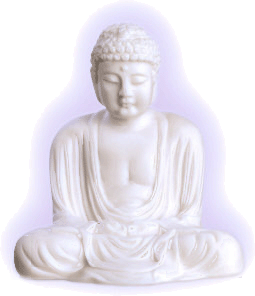The most attractive of all is the attempt to achieve the Malaysian Record for the Largest Lotus made Buddha Footprint. Exactly 84,000 lotuses were used to make this footprint which resembles the 84,000 teachings in Buddhism. Also present was a carving of a footprint which is the reference for the lotus footprint. Lotus represents the purity of the mind, body and actions; it also associated to the Buddha himself.
There's a section in this fest which is quite interesting. It is a booth which is fully covered, leaving 2 openings (1 for entrance and 1 for exit). As we enter into the booth, there a large sign asking this question "Where is Buddha?". As we walk through the corridors of this booth, there were lots of answers on both sides of the wall (all by children, what's more hand-written by them as well). Some of this answer are really funny, such as Buddha is in Brickfield's temple cause I saw him there; Buddha is in my class sitting beside me; What is Buddha is it a type of food? ...etc. At the end of the booth, there are 2 cupboards which has "Buddha is here" written on them. Guess what...after opening the cupboard, all we see is a reflection of ourself in a mirror. It sure was an interesting way to say "Buddha is in ourselves and our hearts!"
 Another activity which also attracts lots of female visitors was the copying of the Chinese Mantras and Sutras. It is said that merits are gain if one sincerely copy and distribute the teachings of Buddhism (Mantras and Sutras). Here visitors get to show off their skill in Chinese calligraphy. To tell the truth, some of them really are wonderful.
Another activity which also attracts lots of female visitors was the copying of the Chinese Mantras and Sutras. It is said that merits are gain if one sincerely copy and distribute the teachings of Buddhism (Mantras and Sutras). Here visitors get to show off their skill in Chinese calligraphy. To tell the truth, some of them really are wonderful.The picture beside is the entrance for this Chinese Mantras and Sutras copying section.
Others are the Wishing well and Bathing of Buddha. Bathing the Buddha is belief to bring blessings to the ones who do it sincerely. As for the Wishing well, personally I think it is an influence from cultural beliefs, because in Buddhism we should not wish for anything but accept and appreciate what we have and what we are.
Another highlight of this fest are the live musical performance on the life of well-known Bodhisattva, such as Avalokitesvara Bodhisattva (Goddess of Mercy, Kuan Yin).
Others activities there are, free distribution of posters, calenders, books and etc. There are items which are sold for charity, such as T-shirts, CDs, DVDs, souvenirs, vegetarian food and etc.
It was a wonderful experience this year, I'll be looking forward for the next Buddhist Art and Culture Fest (hoping it would be held again next year).












